At the heart of the die casting process is the careful creation of a mold that meets the requirements and then the injection of molten metal into the mold under high pressure. As a result, the die casting process is able to create complex metal parts with precision. It transforms ideas into reality, laying the foundation for innovation and design excellence. That’s why die casting is the backbone of today’s leading industries, from automotive to electronics.
In this article, we’ll take an in-depth look at the die casting process and its associated information. For example, from the strategic cooling of cast products to the various materials and uses. For those working in production, understanding all the different types of die casting processes is not only beneficial but necessary.
Table of Contents
What is Die Casting?
Die casting is an efficient and flexible metal casting process. It allows for the production of geometrically complex parts using reusable molds. These molds are often referred to as die casting dies. In die casting, liquid metal is pressed into the mold under high pressure. This is a common method of producing large quantities of parts. Parts produced using the die casting process are accurate, repeatable, and have a smooth surface.
Die casting was first used in the mid-19th century in the printing industry for movable type casting. But it soon made its mark in other areas such as airplanes, electronics, and automobiles. Today, die casting technology primarily uses non-ferrous metals such as magnesium, aluminum, and zinc. This makes it an important process for manufacturing a wide range of products. ranging from tiny, intricate toys to important automotive parts.
Die casting is different from other casting processes. This is because it allows for the manufacture of parts with tight tolerances and virtually no machining. Die castings are favored by manufacturers who want to reduce waste and increase productivity. Because they are economical and have a long service life. Yonglihao Machinery can provide you with quality die casting services.
Ready to get started on your next project? Get a personalized estimate for your parts machining needs.
How Die Casting Works?
The die casting process is conventionally performed by injecting molten metal into a mold under controlled pressure. Typically, the process takes the following steps:
Step 1: Preparing the Mold
Die casting molds come in all shapes and sizes. Here are some types you may want to consider:
- Single Cavity Molds: These are the simplest type of mold. They have only one cavity and can only produce one part per cycle.
- Multi-cavity Molds: These molds are more complex. This is because they have many similar cavities in one mold. It is able to produce many similar parts in one cycle. Therefore, it is used to produce a large number of identical parts.
- Combination Molds: These molds have cavities of different designs inside. Therefore, the combination mold is more adaptable and can produce different types of parts each cycle.
- Unit Mold: This is a special type of mold that allows the production of parts with complex shapes without loss of precision. Die castings with cast-in inserts or thin walls are one example.
Once the mold is made, it needs to be cleaned. This removes any dirt or dust that may affect the quality of the part. It also needs to be preheated to avoid temperature defects such as cracks. Cracks may form when there is a large change in temperature between the mold and the liquid metal.
Learn more about die casting mold design. You can check out the Die Casting Mold Design Comprehensive Guide article for more insights.
Step 2: Injection Process
This depends on whether the chamber is hot or cold at the time of injection. In a cold chamber system, the metal is melted outside the casting machine. In a hot chamber system, on the other hand, the melting of the metal takes place inside the casting machine. The material is then injected into the mold at the appropriate pressure.
Step 3: Cooling
The metal is allowed to cool and solidify in order to make the final part. The mold should remain clamped during the cooling process. In addition, depending on the type of die casting, cooling can take place while the pressure remains constant or increases. For example, in pressure die casting, the metal is cooled at a constant pressure to prevent it from shrinking.
Step 4: Removal
After the casting has completely solidified, remove the fixture from the mold and open the machine’s ejector pin. This allows the solid part to be pushed out. Adding a bevel and greasing the mold before injecting the liquid metal will make it easier to remove the part.
Step 5: Trimming
Die castings need to be trimmed to remove burrs and other defects that leave excess material on the part. To ensure tighter tolerances, trimming can be done in conjunction with post-processing techniques such as grinding. In addition, die castings can receive other metal finishes. This can result in better mechanical properties, functionality, and aesthetics.
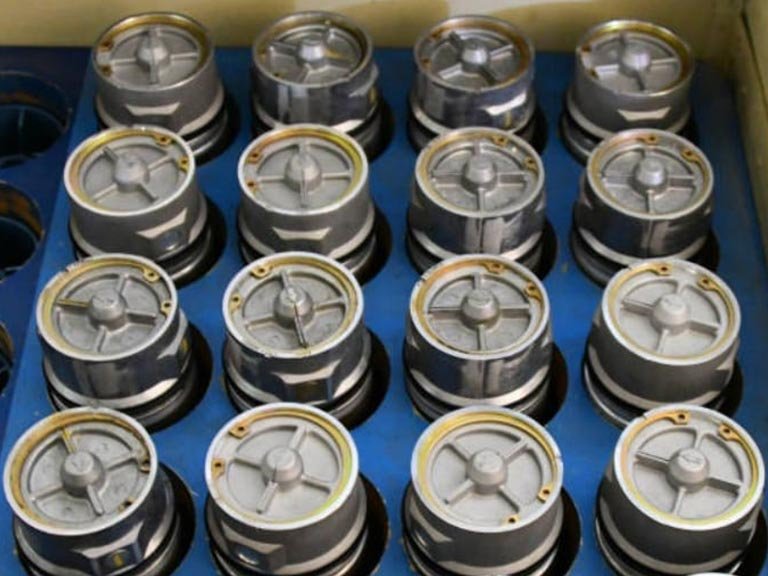
Different Types of Die Casting
Hot chamber die casting and cold chamber die casting are two types of die casting based on the way the metal is melted and injected. The following is a brief description of these two types:
Hot Chamber Die Casting
Hot chamber die casting is one of the most commonly used die casting methods, also known as gooseneck casting. This method is best suited for metals that do not melt easily, such as zinc, magnesium, and some aluminum alloys. The process is fast and efficient and uses a furnace built into the inside of the die casting machine. This makes it possible to produce more products in a rapid cycle.
In addition, the process starts with a pool of molten metal, which is directly connected to the die casting machine. The molten metal is pushed into the mold cavities by a piston driven by pneumatic pressure. This setup not only speeds up the process but also prevents the metal from coming into contact with air. This greatly reduces the probability of oxidizing the metal, making it easier to create stronger, denser parts.
As a result, hot chamber die casting technology is well suited to create small to medium-sized parts that require precise measurements and fine detail. Examples include gears, connectors, and electronic device housings. In addition, hot chamber die casting technology is critical in areas where high-volume production and material integrity are important. This is because it produces high-quality parts with smooth surfaces and consistent dimensions.
Cold Chamber Die Casting
Metals with higher melting points are easily damaged when processed in a hot chamber die casting machine. Such as aluminum, copper, and their alloys. This is why cold chamber die casting is so important. This method is important for making parts that require the high strength and thermal properties that these metals have. It is widely used in the aerospace, heavy machinery, and automotive industries.
In the cold chamber process, molten metal needs to be manually injected into the cold chamber. In this process, a hydraulic or mechanical plunger presses the metal into the mold cavity. The separation of the melting process from the pressing process makes it possible to process high melting point metals. Otherwise, high melting point metals can damage machine parts.
People really like the cold chamber casting process. This is because it makes it possible to manufacture robust and large parts. These parts have excellent mechanical properties and a long service life. In addition, the process can be used for materials with higher melting points and a wider range of alloys. It is therefore essential for the manufacture of critical parts that need to be used in harsh conditions.
Differences Between Hot and Cold Chamber Die Casting
The following is a summary of the differences between hot and cold chamber die casting:
| Hot Chamber Die Casting | Cold Chamber Die Casting |
| Melting occurs inside the casting machine | Melting occurs outside the casting machine |
| Uses a low pressure (1000psi to 5000psi) | Uses a higher pressure (1500psi to 25,000psi) |
| It uses horizontal injection | It uses horizontal and vertical injection |
| Higher energy consumption due to continuous heating | Lower energy consumption since melting takes place outside the machine |
| Suitable for high-volume production of small and intricate parts | Suitable for large intricate parts |
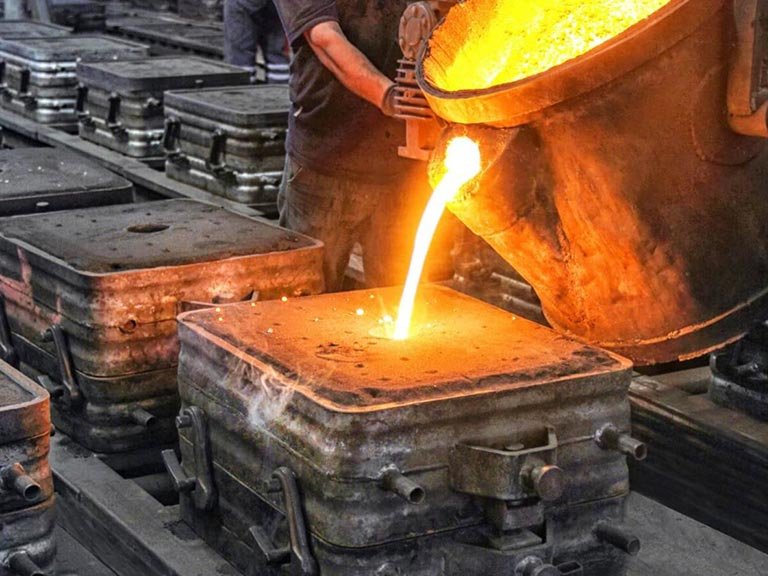
Variations of the Die Casting Process
There are a number of variations of the die casting process in order to adapt it to different needs. You can improve functionality or aesthetics by changing the common templates. These include the following:
Gravity Die Casting
Gravity die casting differs from conventional die casting in that it uses gravity to fill the mold. Advantages of this process include reduced energy consumption, reduced scrap, fewer air bubbles, and improved dimensional accuracy. In addition, the die casting process is applicable to the automotive industry. It is commonly used to manufacture structural components such as engine blocks, cylinder heads, pump housings, and gearbox housings.
Pressure Casting
Low-pressure die casting (LPDC) and high-pressure die casting (HPDC) are two different types of pressure casting. Both types of die casting have their own advantages depending on the filling mechanism. HPDC fills at high pressures (1000 psi to 25,000 psi) and is fast and suitable for producing thin-walled parts. Low Pressure Die Casting (LPDC) filling takes place at low pressure (0.08 MPa to 0.1 MPa). This prevents air trapping and is suitable for manufacturing parts that are dimensionally accurate and non-porous.
In addition, pressure casting is suitable for high-precision machining. For example, the aerospace and automotive industries use it to manufacture structural components such as engine blocks and cylinder heads. The electronics industry, on the other hand, uses it to manufacture electronic housings.
Vacuum Die Casting
The difference between vacuum die casting and normal die casting is that the former uses a vacuum to prevent air from entering. This improves surface finish and dimensional accuracy. The process is used in the automotive, medical, and aerospace industries. Common components include transmission housings, aluminum implants, and brackets.
Extrusion Die Casting
Extrusion castings offer the advantages of improved mechanical properties, reduced porosity, and greater dimensional accuracy. They are therefore used in the automotive industry to manufacture components such as suspensions, steering knuckles, and transmissions.
Semi-solid Die Casting
Semi-solid die casting is also known as thixotropic or rheological casting. It allows the production of parts with tight tolerances and dimensional accuracy. In addition, they are suitable for manufacturing parts with complex geometry. Examples include transmissions, engine mounts, and electronic housings.
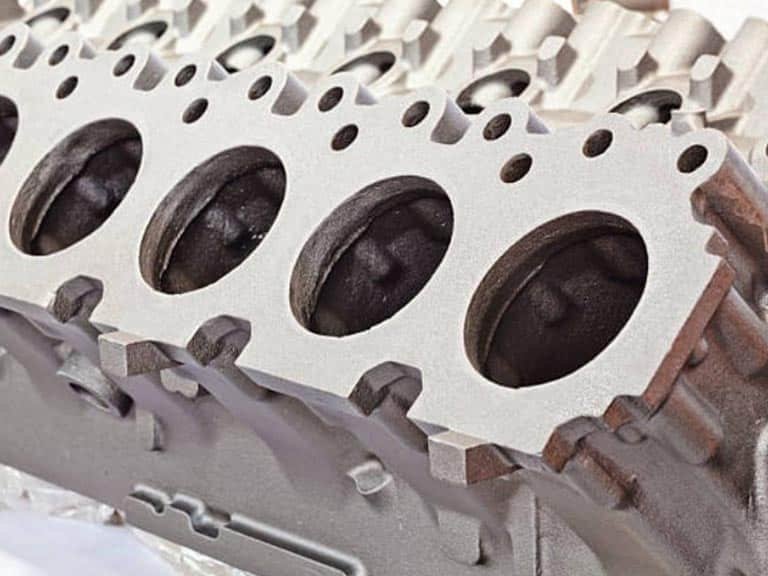
Metallic Materials that Can Be Used in the Die Casting Process
The die casting process can use a wide range of metallic materials. It typically uses non-ferrous metals such as aluminum, magnesium, and zinc alloys. Each metal has unique properties for specific applications.
The following is a comparison of common die casting alloys. Their main properties and typical applications are highlighted:
Aluminum Alloys
- Common Subtypes: A380, A360, A390, A413, ADC12
- Main Components: Aluminum (Al), Copper (Cu), Silicon (Si), Magnesium (Mg)
- Melting Point: 577°C – 660°C
- Main Properties and Applications: Aluminum alloys are versatile and cost-effective. It is lightweight, corrosion-resistant, has a high strength-to-weight ratio, and is highly machinable. It is commonly used in automotive, aerospace, electronics, and consumer products.
Magnesium Alloys
- Common Subtypes: AZ91D, AM60B, AS41B
- Major Components: Magnesium (Mg), Aluminum (Al), Zinc (Zn)
- Melting Point: 632°C – 650°C
- Main Properties and Applications: Magnesium alloys are extremely lightweight and well-cast. It is well suited for weight-sensitive applications. For example, it is used in aerospace, automotive, and electronics.
Zinc Alloys
- Common Subtypes: Zinc Alloys #2, #3, #5, #7, ZA8, ZA27
- Major Components: Zinc (Zn), Aluminum (Al), Copper (Cu), Magnesium (Mg)
- Melting Point: 381°C – 419°C
- Main Properties and Applications: Zinc alloys have excellent castability and a low melting point, which makes them suitable for complex designs. Commonly used in the manufacture of electronics, hardware, toys, and automotive parts.
Copper Alloys
- Common Subtypes: Brass (e.g. C85700), Bronze (e.g. C93200)
- Main Components: Copper (Cu), Zinc (Zn) (Brass); Copper (Cu), Tin (Sn) (Bronze)
- Melting Point: 900°C – 1083°C
- Main Properties and Applications: Copper alloys have high strength excellent electrical conductivity and corrosion resistance. Therefore, it is commonly used in pipes, electrical connectors, ship components, and bearings.
Tin Alloy
- Main Components: Tin (Sn) (90%), Copper (Cu) (2.5%), Lead (Pb) (7.5%), Antimony (Sb)
- Melting Point: 170°C – 230°C
- Main Properties and Applications: Tin alloy has a low melting point, good mobility, and corrosion resistance. Therefore, it is mainly used for decorations, figurines, and jewelry.
Lead Alloys
- Main Components: Lead (Pb), Tin (Sn)
- Melting Point: 183°C – 327°C
- Main Properties and Applications: Lead alloy has the advantages of softness, low melting point, and corrosion resistance. It is often used for radiation shielding.
Tin-based Alloys
- Main Components: tin (Sn), copper (Cu), antimony (Sb)
- Melting Point: 232°C
- Main Properties and Applications: Tin-based alloys have a low melting point, are easy to cast, and have good corrosion resistance. Commonly used in electronics, jewelry, and specialty applications.
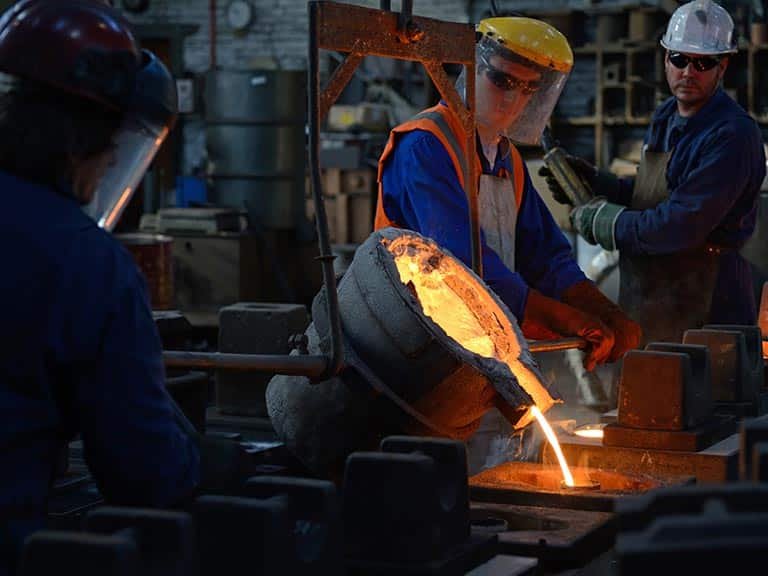
Die Casting Design Considerations
Understand that variations in materials and casting processes can affect the quality of a part. However, you should also consider the following geometric features. This can improve part performance, manufacturability, and cost-effectiveness.
Draft
The draft slope is the slope of the mold in the vertical direction and is used to facilitate part release. However, the angle depends on the casting material, surface finish, wall thickness, and geometric complexity.
Failure to use a draft taper in mold design can result in the part sticking or dragging the mold during demolding. As a result, this can damage the part of the mold. However, using a larger draft taper can increase material usage and manufacturing costs.
Typically, an extraction taper of 10 to 20 improves part launch. For a typical aluminum die casting, the recommended draft slope is 20 per side to accommodate the abrasive nature of the material. Zinc, on the other hand, has a shrinkage rate of 0.7%, which can be taken into account in the mold design.
Fillet Radii
In part design, fillet radii are important in cases where sharp corners cannot be avoided. They reduce stress concentrations at sharp corners by distributing the stresses evenly throughout the part. The fillet radius depends on the geometry of the part, the casting material, and the functional requirements.
The recommended minimum fillet radius is 0.4 mm, but the maximum is 0.8 mm. Larger fillet radii reduce stresses. However, this can increase material usage and machining costs. On the other hand, a smaller fillet radius may not provide sufficient stress relief.
Parting Line
The parting line is the line where the two mold halves intersect. It is necessary to ensure that the parting line is straight. In addition, the positioning and orientation of the parting line must be minimized to minimize its visibility and not interfere with the function of the part. Factors such as part geometry, undercuts, draft slopes, and gates can affect the location of the parting line.
Wall Thickness
Ensuring consistent wall thickness is critical to avoid shrinkage porosity and achieve uniform cooling. Sudden changes in wall thickness can lead to stress concentrations, which often result in defects. The ideal wall thickness is influenced by a number of factors. Proportions such as the specific aluminum alloy, the overall size and design of the part, and the application. Therefore, prioritizing wall thickness uniformity helps maintain stable cooling and reduces the potential for defects.
Bosses
Bosses are additions to die castings used as mounting points. For maximum strength, bosses should have a uniform wall thickness. When selecting bosses, their diameter, height, and wall thickness should be considered. In addition, bosses that are too large or too small can lead to assembly problems, part distortion, or reduced part strength.
Ribs
Ribs are thin, raised features. It increases part strength without increasing part weight or material usage. In addition, it minimizes part distortion and improves dimensional stability. The use of excessively thick or thin ribs can result in denting or warping. Therefore, the size, shape, thickness, aspect ratio, and spacing of the part should be considered when selecting ribs.
Holes and Windows
Well-designed holes and windows can be used for ventilation, drainage, or component integration. Designers should consider the diameter, depth, and location of holes during integration. This can prevent part defects or functional problems.
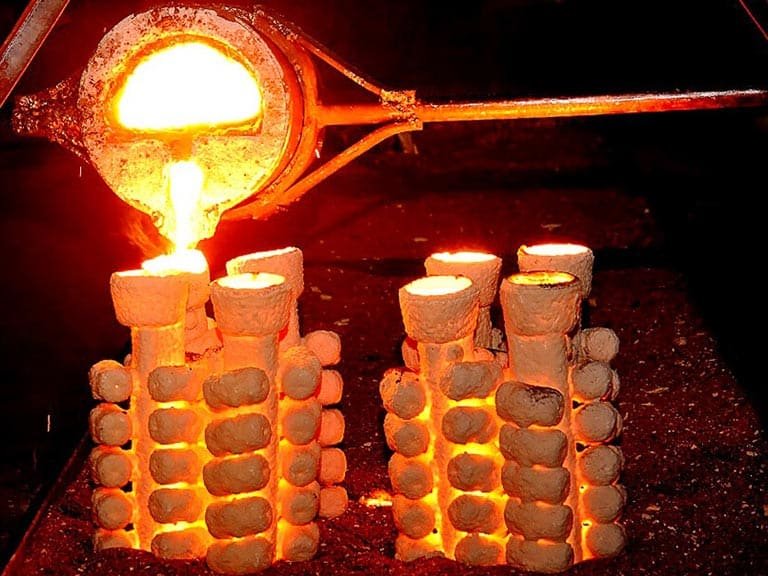
Die Casting Applications and Uses
The die casting process is used in industries that use non-ferrous materials such as aluminum, zinc, and magnesium. Examples:
Aerospace: The aerospace industry uses metal casting to manufacture aircraft engine components. For example, aluminum alloys (e.g., ADC12, A380) and magnesium alloys (e.g., AZ91D) are used to make casings and mounts. The die casting process ensures dimensional accuracy and is suitable for the complex geometries that characterize this industry. Therefore, the industry relies on the die casting process.
Automotive: The automotive industry uses this manufacturing process to produce engine components. Examples include cylinder heads, transmission housings, blocks, and body parts. Automotive die casting materials used in this industry include aluminum alloys (e.g., ADC12, A380), zinc alloys (e.g., ZAMAK), and magnesium alloys (e.g., AZ91D).
Electronics Industry: Die casting is also used to manufacture electronic components such as connectors, heat sinks, and housings. The manufacturing process allows for the precise fabrication of complex parts common in the electronics industry.
Consumer Products: Consumer products such as kitchen utensils, power tools, and other hardware are manufactured using aluminum, zinc, and tin alloy die casting processes. The die casting process is characterized by high productivity, high volume and low cost. These characteristics are essential for the manufacture of these products.
Construction Industry: The construction industry utilizes the die-casting process to manufacture hardware such as hinges, window frames, and fixtures. This manufacturing process allows for the production of parts with complex shapes. It also ensures that these parts are functional and aesthetically pleasing at the same time.
Advantages of Die Casting
Die casting of metals has a number of advantages over other manufacturing processes. These advantages include:
Excellent Accuracy: The die casting process produces parts with high dimensional accuracy. However, the accuracy depends on the type, variation, and pre-design of the die casting mold. For example, molds made with advanced CNC machines, such as 5-axis CNC machines, can achieve tight tolerances.
Complex Details: This process allows for the manufacture of parts with complex geometries, including cast-in inserts, thin walls, and more. This ability to incorporate complex details into the design makes it possible to produce parts with different shapes and functions.
High Volume Rapid Delivery: This is a high-volume production process with a low unit cost. However, the speed depends on the casting process and mold design. For example, high-pressure casting is fast due to the use of high pressure. The use of multiple combination molds can increase speed, and quantity, and reduce unit cost.
Smooth Surface Finish: Casting metal parts has a smooth surface finish. Especially when using techniques such as low-pressure casting, gravity casting, and semi-solid casting. Controlled pressure ensures that the mold is well-filled, which improves dimensional accuracy and reduces air entrapment, thus ensuring minimum porosity. Shell molding is also a better option if you need better part surface smoothness.
Long Mold Life: Molds are usually made from high-quality steel. This steel is tough and able to withstand the high pressures and temperatures involved in the die casting process. Therefore, the robustness and durability of the steel are key to the life of the die.

Disadvantages of Die Casting
There are also some limitations to metal die casting. These limitations determine whether you can use it or not. This section describes these limitations and how to overcome them.
Applicable to Non-Ferrous Metals: It is only applicable to non-ferrous metals with medium melting points, such as aluminum, zinc, and magnesium. Ferrous metals such as steel have higher melting points and require special equipment for casting.
High Mold Cost: The manufacturing cost of die-casting molds is high, mainly because metal die-casting requires precise mold design and multi-process machining, such as CNC machining and EDM. In addition, the handling of complex parts and the use of high-hardness steel increases the difficulty and cost of mold manufacturing.
Susceptibility to Defects: Depending on the type and variation of die casting, parts are susceptible to defects such as porosity, shrinkage, and surface imperfections. For example, air bubbles are created in high-pressure casting and form pores on the surface of the part. These air pockets can form bubbles during heat treatment. Addressing these defects can lead to additional surface preparation processes, which can increase manufacturing costs.
Not Suitable for Small Projects: Die casting has a high initial investment cost, including setup costs, mold manufacturing, etc. In order to reduce the cost per unit part, mass production is encouraged. Therefore, the die casting process is not suitable for small-scale projects and one-off part production.
Comparison of Die Casting with Other Manufacturing Processes
Die casting may be confused with processes such as injection molding and forging. However, the following differences exist between them:
Differences Between Die Casting and Injection Molding
Die casting and injection molding are two processes frequently used in manufacturing. Both use the same injection molding principles and are suitable for manufacturing parts with intricate detail and excellent surface finish.
However, they differ in terms of workpiece and mold materials. Injection molding uses steel or aluminum molds and is only suitable for plastic polymers. Die casting, on the other hand, is suitable for non-ferrous metals and uses steel molds. Other differences between the two processes are shown in the following table:
| Differences | Die Casting | Injection Molding |
| Process | Metal injection into a predesigned steel mold under pressure | Molten plastic injection into a predesigned steel or aluminum mold under pressure |
| Material | Non-ferrous metal alloys (e.g., aluminum, zinc, magnesium) | Thermoplastic or thermosetting plastics |
| Mold materials | Steel | Steel or aluminum |
| Cooling time | Longer cooling times | Shorter cooling times |
| Production Speed | Slower | Faster |
| Tooling cost | Higher die casting tooling costs due to the use of steel molds | Lower tooling cost due to the use of aluminum molds |
| Part cost | Higher part costs due to longer production times | Lower part cost due to faster production times |
Differences Between Forging and Die Casting
The main difference between forging and die casting is the use of molds. Forging involves molding heated metal by applying pressure. Die casting, on the other hand, involves injecting molten metal into a predesigned mold. The difference between the two metal fabrication processes is shown in the table below.
| Differences | Forging | Die Casting |
| Process | Involves shaping the metal by applying compressive forces | Injection of the metal in a molten state into a mold under pressure |
| Material | Suitable for ferrous and non-ferrous metals e.g., steel and aluminum | Suitable for only non-ferrous metals like aluminum, zinc, magnesium |
| Mold Material | Does not require a mold. But it uses a die | Steel molds |
| Production Speed | Slower | Faster |
| Tolerance Control | Moderate tolerance | High tolerance control due to the precision mold manufacturing process |
| Final Part Properties | Improved mechanical properties due to the forging process | Mechanical properties depend on the casting material |

Selecting the Right Die Casting Service Provider
Die casting is a simple metal fabrication process. However, it may require specialized knowledge and experience. Utilizing advanced die casting technology ensures greater precision and higher quality. Therefore, outsourcing to a specialized service provider like Yonglihao Machinery is a better way to go.
At Yonglihao Machinery, our team of engineers has years of experience in die casting services. We are in a better position to advise you on the right die casting process for your project. With our state-of-the-art facilities, we are able to ensure the production of high-quality parts.
Summary
Die casting is a metalworking process with high dimensional accuracy. It can produce accurate, smooth-surfaced parts for you in large quantities. If you need related information or service, please contact us. Yonglihao Machinery will provide you with a short lead time, and cost-effective and high-quality manufacturing service.
FAQs
Do Die Casting Products Last a Long Time?
Yes, the parts last a long time. But how long something lasts depends on the stuff it’s made of and where it’s used. Also, regular care can make the part last longer.
Does Post-Machining Always Have to Be Done after Die Casting?
No, the post-machining varies on what the part needs. In order to get a better surface finish or a tighter tolerance, some parts may need extra cutting steps like grinding. In addition, the casts can also be left blank for the next step in the production process.
Is It Possible to Use Die Casting to Make Prototypes?
Metal die casting is not a good method for testing. This is because it takes a long time and costs a lot to make the molds. You can make prototypes with 3D printing or CNC machining instead, and then make a lot of production with die casting.
Can die casting be used for producing parts with complex geometries?
Yes, we use die casting to produce parts with complex geometries. The process can create intricate details and shapes. This makes it ideal for a wide range of applications, from automotive to consumer products.
What are the most commonly used alloys in die casting?
Aluminum, zinc, and magnesium alloys are the most commonly used materials in die casting. Each of these materials offers unique properties, such as strength, corrosion resistance, and thermal conductivity. This makes them suitable for various applications.
How does the hot chamber die casting process differ from cold chamber die casting?
In hot chamber die casting, the molten metal is held in a furnace within the machine, and the metal is injected into the mold using a gooseneck. In contrast, cold chamber die casting involves ladling the molten metal into a separate chamber, from which it is injected into the mold. We use both processes, depending on the material and the specific requirements of the part.
What are the advantages of using CNC machining as a secondary process for die-cast parts?
CNC machining allows us to achieve precise dimensions and surface finishes on die-cast parts. We use CNC machining to add features that are difficult or impossible to achieve through die casting alone. Such as complex holes or tight tolerances.
Can die casting be used for producing large parts?
While die casting is often associated with smaller parts, we can produce larger parts using this process. The size of the part is limited by the size of the machine and the mold. But we have the capability to produce parts weighing up to several kilograms.
How do we ensure the quality of die-cast parts?
We ensure the quality of die-cast parts through a combination of process control, inspection, and testing. Our quality control measures include monitoring the injection process, inspecting parts for defects, and performing mechanical testing to verify the properties of the material.

